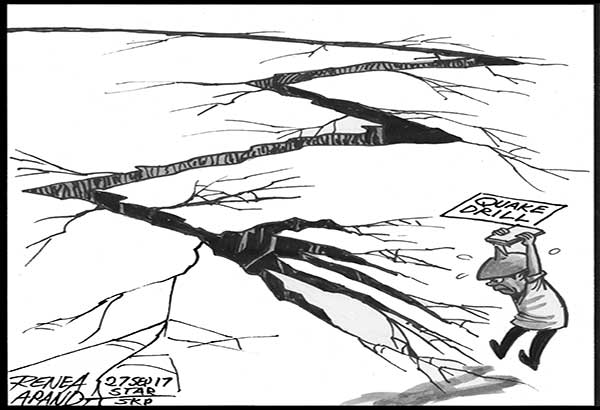EDITORIAL - Earthquake drill

Once again, earthquake drills will be held simultaneously today across the country. The drills, administered by the National Disaster Risk Reduction and Management Council, are being held just days after a magnitude 5.4 quake rocked the town of Wao in Lanao del Sur, with residents also feeling aftershocks.
The drills will be held as Indonesians brace for the likely eruption of Mt. Agung, which sits just around 75 kilometers from the popular tourist destination of Kuta on the resort island of Bali.
In Mexico, people are still reeling from the 7.1 magnitude quake that struck Puebla state last week, killing over 200 people. It was the most powerful quake to hit the country since the magnitude 8 earthquake that left about 5,000 people dead in Mexico City in September 1985. The Puebla quake was followed days later by a 6.2 magnitude temblor that struck Mexico City.
Clearly there is movement around the Pacific Ring of Fire, which gives urgency to boosting preparedness for a strong earthquake. The nation cannot be reminded enough that large tracts of the Philippines’ most populous region sits along the West Valley Fault, which seismologists have warned is ripe for the so-called Big One.
Seismologists have released detailed maps of the West and East Valley Faults, which cut across Metro Manila and parts of Laguna and Cavite. Despite warnings about the Big One and cracks on the ground at certain spots, residents and owners of establishments along the faults have opted to take their chances and refused to move to less risky areas.
Earthquake prediction is not an exact science, and the Big One might not strike within the next half century. But with volcanoes acting up and the ground moving along the Pacific Rim, nations along the Ring of Fire cannot afford complacency.
Today’s drills will involve orderly evacuations as usual together with exercises in rescue and retrieval operations. The nation, however, needs more preparations and equipment to deal with fires, collapsed buildings and damaged roads in case of a catastrophic earthquake. Serious disruptions can be expected in food supply networks as well as in water, electricity, telecommunications and transportation services. Health centers can be overwhelmed. Recent disasters in other countries show that one can never be over-prepared for a powerful earthquake.
- Latest
- Trending






















